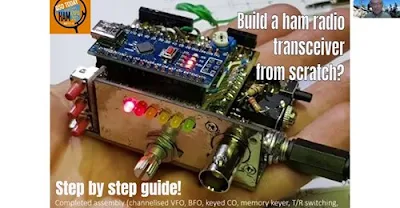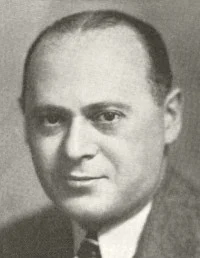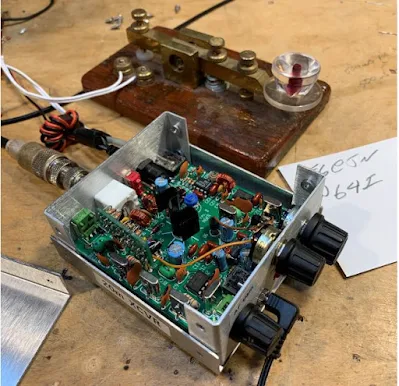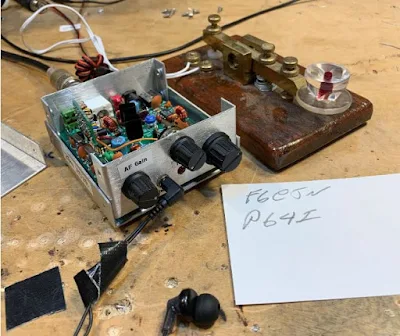Serving the worldwide community of radio-electronic homebrewers. Providing blog support to the SolderSmoke podcast: http://soldersmoke.com
Podcasting since 2005! Listen to Latest SolderSmoke
Friday, June 18, 2021
Jean Shepherd on CW, and Strange Propagation -- QRP!
Thursday, June 17, 2021
The Stubborn Myth about USB and LSB
It has been repeated so often and for so long that many of us have come to believe it. I myself believed it for a while. Like many myths, it has a ring of truth to it. And it is a simple, convenient explanation for a complex question:
Why do ham single sideband operators use LSB below 10 MHz, but USB above 10 MHz?
Here is the standard (but WRONG) answer:
In the early days of SSB, hams discovered that with a 9 MHz SSB generator and a VFO running around 5.2 MHz, they could easily reach both 75 meters and 20 meters (True). And because of sideband inversion, a 9 MHz LSB signal would emerge from the mixer as an LSB signal (True), while the 20 meter signal would emerge -- because of sideband inversion -- as a USB signal (FALSE!) That sideband inversion for the 20 meter signal explains, they claim, the LSB/USB convention we use to this day.
Why this explanation is wrong:
There is a very simple rule to determine if sideband inversion is taking place: If you are subtracting the signal with the modulation FROM the signal without the modulation (the LO or VFO) you will have sideband inversion. If not, you will NOT have sideband inversion.
So, you just have to ask yourself: For either 20 or 75 are we SUBTRACTNG the Modulated signal (9 MHz) from the unmodulated signal (5.2 MHz)?
For 75 meters we have: 9 MHz - 5.2 MHz = 3.8 MHz NO. We are not subtracting the modulated signal from the unmodulated signal. There will NOT be sideband inversion.
For 20 meters we have 9 MHz + 5.2 MHz = 14.2 MHz. NO. No subtraction here. No sideband inversion.
So it is just arithmetically impossible for there to be the kind of happy, easy, and convenient USB/LSB situation described so persistently by the myth.
---------------------------------
We discussed this several times on the podcast and in the blog:
https://soldersmoke.blogspot.com/2015/05/sideband-inversion.html
https://soldersmoke.blogspot.com/2012/05/usblsb-urban-legend-debunked.html
This myth shows up all over the place:
We see the myth here:
http://n4trb.com/AmateurRadio/Why%20The%20Sideband%20Convention%20-%20formatted.pdf
Here the web site owner warns that this is "highly controversial." Really? Arithmetic?
The myth is very old. Here is a clip from a 1966 issue of "73" magazine:
https://worldradiohistory.com/
Finally, to my disappointment, I found the myth being circulated by the ARRL, in the 2002 ARRL Handbook page 12.3:
Tuesday, June 15, 2021
Hi Def 360 Degree Panorama from the Mars Perseverance Rover
Monday, June 14, 2021
M0NTV's Latest FB SSB Transceiver
Santo Domingo Shack on 12th Floor Balcony -- SST QRP CW
Saturday, June 12, 2021
Good News! The Termination Event May Be Coming Soon! Solar Cycle 25 Could Rival Cycle 19!
Thanks to Thomas over at SWLing Post for alerting us to this important news.
Thursday, June 10, 2021
Tom's Receiver -- A 20 Meter Superhet Built From the Junkbox
Wow, this is really an amazing project. It is so good that I'd like to believe that it is really "all our fault," but the credit obviously goes to Tom, the very intrepid builder. In a more just world, Tom would be given a ham radio license solely on the basis of this project. Great work Tom. We look forward to more Solder Defined Radios from your workbench.
I stumbled across your podcast a few years ago. I had no interest in
amateur radio, I was just looking for an electronics podcast that
actually discussed electronics (naming no names here, obviously).
Well, the inevitable happened, and some of your enthusiasm rubbed off
on me. I now find myself humbly enclosing a photograph of my first
homebrew receiver for 20m.
The project was one of those "spontaneous construction" affairs,
triggered mainly by breaking up an old satellite receiver (I've
honestly no idea what it was for) which yielded up several SBL1s and a
10.7MHz crystal filter - these form the key elements of the new
receiver. It's a full SDR (solder defined radio) of a conventional
single-conversion superhet arrangement. The chief abnormality is that,
because the IF filter is as wide as the proverbial barn door, I only
use "one edge" - the other half of the passband being provided after
conversion to baseband. Of course, that only works if there are no
massively strong stations in the 6kHz above where you're listening,
but it seems to be ok most of the time. It does give me the advantage
of being able to adjust the lowpass point of the AF signal by
adjusting the BFO, which is nice.
You'll notice there's a lot of "digital nonsense" in the picture, for
what's supposed to be an analogue radio. This "supervises" the two
VCOs: There is an FPGA which implements a pair of frequency meters and
an STM8 microcontroller which is in charge of adjusting the control
voltages to keep the VCOs where they should be. It's all slightly
roundabout because I wasn't clever enough to design a PLL which would
give the required resolution (and I wanted to do something "more RF"
than throw down a DDS chip).
This gives me stability as well as fancy bells and whistles, like
numeric readout, tuning info via RS232, automatic scanning and
frequency presets. I've used a (cheap) industrial/automation style
encoder for the tuning control, which gives a lovely analogue-like
action.
Despite my best efforts (and a lot of ferrite in strategic places) I
wasn't able to keep all the digital spurs out of the receiver. So I
devised a dirty hack by way of a button which will shift the MCU an
DAC clocks to a different frequency. I can't remove the spurs, but now
I can hide them!
So far I've played with a "long" wire and a little shielded loop for
antennas - I'm in a first floor flat with a lot of noise locally, and
my plan is to get a loop up in the loft space (so the next project
might be a rotator!). I fancy maybe seeing if I've space for an
inverted V, too.
You'll notice that I've not attempted a transmitter. That, of course,
is because I'm not yet a licenced ham! However, I'm intending to put
that right sometime later in the year. Then - who knows - I might make
a contact!
Thanks for reading (although really it's the least you could do given
that this *is* all your fault) and I hope you've enjoyed hearing about
all the trouble your little podcast has got me into.
Keep up the good work gentlemen,
73 from South-West England.
Tom.
PS. I also have a copy of Bill's book, which I've very much enjoyed.
Wednesday, June 9, 2021
Pete's Drakes
Monday, June 7, 2021
Dino's Test Gear -- KL0S at FDIM 2021
Sunday, June 6, 2021
VK3HN on Scratch Building (Video)
Lots of wisdom and good info in Paul Taylor's presentation.
Paul's comment on the impact of abundant LiPo power in the field -- we no longer have to scrimp and optimize power consumption -- was very interesting.
And thanks for the nice mentions of the SolderSmoke podcast.
Thanks Paul!
Saturday, June 5, 2021
Friday, June 4, 2021
To Mars in 1964 -- Building the Camera and Radio Systems
Thursday, June 3, 2021
Remastered! The Secret Life of Radio -- With Updated Comments from Tim Hunkin
Sunday, May 30, 2021
QRP - QRP Contact from Dominican Republic
Friday, May 28, 2021
Farhan's sBITX -- Combining SDR with the Traditional Superhet
Wednesday, May 26, 2021
TRGHS: K3ZO heard from the Dominican Republic
We arrived in the DR just yesterday, and this morning was my first chance to do some ham radio stuff. I fired up my old Sony SW receiver (the one with the busted BFO fine tuning control) and tuned to 20 meters. The very first station I tuned in (after adjusting the BFO with my Swiss army knife) was talking about the Cicadas. He described weather similar to that which we had just left in Northern Virginia. Then I heard the call: K3ZO. It was Fred Laun up in Maryland! When I first came to the DR in 1992, the locals were talking about Fred as if he had just recently past through. I learned, however, that he had been there during the 1960s! He had left quite an impression. He had saved one of the local hams during the 1965 political violence. I gave that same local ham some Vibroplex parts so that he could fix up an old bug that Fred had left him.
Wow, it was really cool to have Fred Laun be the very first ham I hear during this trip. The Radio Gods Have Spoken. We need to spend more time (especially winter time!) in the DR!
I have a video of this listening session that I will post when we get back to Virginia.
Tuesday, May 25, 2021
Monday, May 24, 2021
Parasets, Parachutes, and Tubes in "A French Village" Season 3
https://en.wikipedia.org/wiki/Un_village_fran%C3%A7ais
In season 3, Episodes 7 and 8, resistance members parachute in from London. They are equipped with what looks a lot like a paraset. One of their tubes develops an open filament. The Germans engage in radio direction finding. The Morse code is fairly good (but not great). All in all, there is quite a bit of radio-related material.
"A French Village" is a very well-done series. But it is (of course) quite dark.
Sunday, May 23, 2021
Michigan Mighty Mite, Joy of Oscillation, and the Color-Burst Liberation Army in Washington State
Saturday, May 22, 2021
VK3HN's Homebrew 30 Meter SST QRP Transceiver
Friday, May 21, 2021
AA7EE's Amazing Homebrew SST QRP Transceiver
Look at that rig. It is truly a thing of beauty.
I was very pleased to see Dave AA7EE's comment on my SST rig. This caused me to search his site for his SST article. And wow, it is an SST treasure trove. Lots of discussion of the circuit and mods. And Dave's usual wonderful photography and videography.
Check it out.
https://aa7ee.wordpress.com/2016/09/09/a-scratch-build-of-n6kr-and-wilderness-radios-sst-for-20m/
Thanks Dave!
Thursday, May 20, 2021
Cicadas Arrive in Northern Virginia
Usually the only bugs we talk about here are dead bugs (components with their leads up on circuit boards) or perhaps CW keying devices. But in the last podcast I mentioned the arrival in Northern Virginia of Brood X Cicadas. They are coming to the surface after 17 years underground. This morning I found this amazing animation that explains the lifecycle of these fascinating creatures.
This morning Elisa mercifully took the time to take several dozen of them off the tires of her car.
Here is the animation. Just scroll down to follow the life cycle.
Be sure to turn on the audio!
The SST QRP Transceiver
https://qrpbuilder.com/wp-content/uploads/2017/04/sst_manual_042217.pdf
Tuesday, May 18, 2021
HRDX Interviews Paul Taylor VK3HN
Monday, May 17, 2021
Bill N2CQR Talks to Dean KK4DAS about the Simple SSB Group Build
https://kk4das.blogspot.com/
Saturday, May 15, 2021
SolderSmoke Podcast #230 is available! Apr 1, Mars, Group Build, SDR, SSB, Mich Mighty Mites, Mailbag
SolderSmoke Podcast #230 is available for download
http://soldersmoke.com/soldersmoke230.mp3
























